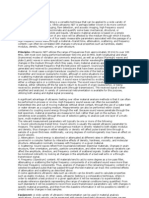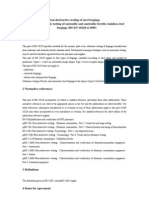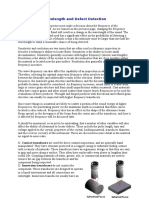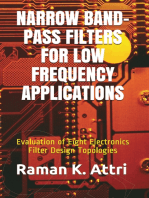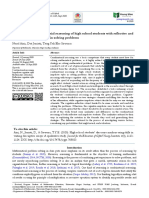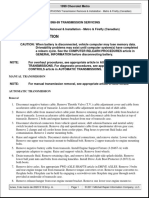0 ratings0% found this document useful (0 votes)
21 viewsNormal probe
Uploaded by
Prudvesh ChCopyright
© © All Rights Reserved
Available Formats
Download as PDF, TXT or read online on Scribd
0 ratings0% found this document useful (0 votes)
21 viewsNormal probe
Uploaded by
Prudvesh ChCopyright
© © All Rights Reserved
Available Formats
Download as PDF, TXT or read online on Scribd
You are on page 1/ 1
Normal beam probe for contact testing :
Normal beam probes are useful for detecting discontinuities with
reflecting plane parallel to the scanning surface. These probes are
used on relatively flat and smooth surfaces to introduce longitudinal
wave into the test material. The common applications are ; testing of
plates, forged and rolled products, castings, thickness and velocity
measurements.
Frequencies between 0.5 to 6 MHz is normally used in contact
testing, because the high frequency crystals are thin and fragile.
High frequency contact probes in smaller crystal sizes are available
with some additional protection. Standard test frequency is 2 - 2.25
MHz. Crystal size of 6.4, 10, 12.7, 19 and 24 mm are most
common. Lower frequencies and larger crystals, are used on long
parts and coarse grained materials. High frequencies and smaller
crystals, are used on thin or fine grained materials. Smaller, high
frequency probes are highly sensitive for short range flaw
detection.
A single crystal probe has a dead zone [ ringing time of the
active element / width of the initial echo on the CRT screen ] and
can not detect discontinuities located within this distance. Scanning
from the opposite parallel surface overcomes this problem.
The main components in the probe are,
Active element : The active element [ or the crystal ] is a piezo
electric ceramic which converts electrical energy received from the
flaw detector’s pulser to mechanical vibrations for generating
ultrasound in the test material. It also converts mechanical
vibrations to electrical charge for detecting ultrasound reflections.
Silver conductive coating on the active faces serve as electrodes.
Backing medium : Backing medium is a highly attenuative, high
density material, attached to the back of the crystal to control the
vibration by absorbing the energy radiated from the back surface.
Tungsten powder / Epoxy mixture is often used. The purpose is to
eliminate unwanted and prolong vibration of the crystal. This is
called damping. Careful consideration of the characteristics
[ acoustic impedance ] of this backing material enable the designer
to produce either a very wide band, but lower sensitivity or a
narrow band, but higher sensitivity probe. High damping reduces
dead zone, improves resolution but reduces the overall sensitivity
and thickness penetrating power of the probe.
Wear plate : The wear plate protects the soft silver coated surface
of the crystal from corrosion and wear by friction during contact
testing. A permanently attached ceramic disc or a coating of
abrasive material on the front face is used as the rubbing face.
This offers only limited protection. Replaceable plastic membrane or
nylon wear cap is most popular. Delay line attachments are also
used to reduce dead zone and improve the ability to measure thin
materials and small flaws. Delay line can be contoured to match
curved test surfaces to improve sound transmission. Dry coupling
and short duration testing at high temperature [ 10 sec scan / 60 sec
0
off, 900 F ] delay line options are available. When using a delay
line, there will be multiple back reflections from the end of it.
Performance : The probe should produce a 75 % signal indication Crystal Size mm :
from the 1.5 mm diameter drilled hole in a standard IIW -V1 block 3 / 5 [ HF ] applications on small contact area.
with a reserve gain of 40 dB or more, when used with a standard 6.4 [ HF ] curves, corrosion, de-lamination, thk, tubing
flaw detector. [ sensitivity ] [ with delay line applications ]
The probe, with a standard flaw detector, should produce clearly 10 mm complex shapes, small parts, flat / round
separated 75% height indications from the three distances bars, tubing, thickness, flaw sizing.
[ 85, 91, 100 mm ] in the IIW-V1 block. [ resolution ] 19 / 24 mm plate, ingot, slab, billet, axels, rolls, big
The probe should have low dead zone and low noise. wheels and gears, large forgings and
Probe applications [ in metals ] : castings etc.
.5 / 1 MHz cast Iron, brass, mill rolls, copper, stainless steel, Paint brush [ multiple element ] for plate testing.
[ 24 dia ] sound scattering materials, long parts. Wheel type probe mounted in liquid filled rubber
2 / 2.5 MHz standard test applications. Tire with adjustment for normal, angular
4 MHz thinner parts, aluminium, thk chk, flaw measurements. and surface wave scanning of large
5 / 10 MHz fine grained materials, inclusions, thin matetrials, bonding parts such as plates, billets etc.
thickness measurement. Note : For curved surface, it is recommended to use
High frequency probe will completely miss a disoriented reflector a suitably designed contoured acrylic adapter. This
because the reflected beam is highly directional. will improve transmission of energy, reduce dead
zone. Length of the adapter to be used such that
the part’s back reflection appear before the adapter’s
back reflection.
K. Chatterjee, 75643 Center for NDT P 00 Rv 02 Self study material.
You might also like
- Longitudinal: Normal Beam Probe For Contact TestingNo ratings yetLongitudinal: Normal Beam Probe For Contact Testing1 page
- Experiment No.: 05 Objective: To Check The Linearity of Ufd and Determine The LocationNo ratings yetExperiment No.: 05 Objective: To Check The Linearity of Ufd and Determine The Location4 pages
- Crystal THK / 2, Wave Length in Crystal: Piezo-Electric EffectNo ratings yetCrystal THK / 2, Wave Length in Crystal: Piezo-Electric Effect1 page
- UL TRA Sonic TES Ting: Afnor Associated StandardsNo ratings yetUL TRA Sonic TES Ting: Afnor Associated Standards2 pages
- Conocimiento Medición Del Espesor Por Ultrasonidos: by Tom NelliganNo ratings yetConocimiento Medición Del Espesor Por Ultrasonidos: by Tom Nelligan5 pages
- SW2008.Critical Comparison of Ultrasonic Pile Testing StandardsNo ratings yetSW2008.Critical Comparison of Ultrasonic Pile Testing Standards5 pages
- Eddy Current Probe Types and Their UsageNo ratings yetEddy Current Probe Types and Their Usage4 pages
- Ultrasonic Testing of Austenitic and Austenitic Ferritic Stainless Steel Forgings100% (2)Ultrasonic Testing of Austenitic and Austenitic Ferritic Stainless Steel Forgings17 pages
- A MEMS Ultrasonic Transducer For Monitoring of Steel StructuresNo ratings yetA MEMS Ultrasonic Transducer For Monitoring of Steel Structures9 pages
- Material Science and Engineering DJJ 30113No ratings yetMaterial Science and Engineering DJJ 3011318 pages
- UT Level I - Standar Operating ProcedureNo ratings yetUT Level I - Standar Operating Procedure2 pages
- Vanderwielen2017 - GPR V Ultrasonic TomographyNo ratings yetVanderwielen2017 - GPR V Ultrasonic Tomography6 pages
- Characteristics of Piezoelectric TransducersNo ratings yetCharacteristics of Piezoelectric Transducers50 pages
- Eddy Current Probes and Accessories Catalogue: GE Inspection Technologies100% (1)Eddy Current Probes and Accessories Catalogue: GE Inspection Technologies13 pages
- Pcn Time of Flight Diffraction (Tofd) MaterialNo ratings yetPcn Time of Flight Diffraction (Tofd) Material151 pages
- Narrow Band-Pass Filters for Low Frequency Applications: Evaluation of Eight Electronics Filter Design TopologiesFrom EverandNarrow Band-Pass Filters for Low Frequency Applications: Evaluation of Eight Electronics Filter Design TopologiesNo ratings yet
- Microstrip and Printed Antennas: New Trends, Techniques and ApplicationsFrom EverandMicrostrip and Printed Antennas: New Trends, Techniques and ApplicationsDebatosh Guha4/5 (1)
- Measurement While Drilling: Signal Analysis, Optimization and DesignFrom EverandMeasurement While Drilling: Signal Analysis, Optimization and DesignNo ratings yet
- Document numbering & Control Procedure-Panametrics-1No ratings yetDocument numbering & Control Procedure-Panametrics-114 pages
- IMRAD Introduction Methods Results and Discussion 1No ratings yetIMRAD Introduction Methods Results and Discussion 12 pages
- Contemporary Philippine Arts IntroductionNo ratings yetContemporary Philippine Arts Introduction16 pages
- Team Teaching: Exploring The Curriculum: Compostela Valley State CollegeNo ratings yetTeam Teaching: Exploring The Curriculum: Compostela Valley State College22 pages
- Training Plan - 101769488 - TP - 61084 - V1No ratings yetTraining Plan - 101769488 - TP - 61084 - V14 pages
- Lesson 5 (PHILOSOPHIES OF BUSINESS PRACTICES)No ratings yetLesson 5 (PHILOSOPHIES OF BUSINESS PRACTICES)70 pages
- Transmission Removal & Installation - Metro & Firefly (Canadian)No ratings yetTransmission Removal & Installation - Metro & Firefly (Canadian)2 pages
- Css Ro Details Modified Final-1310202343No ratings yetCss Ro Details Modified Final-13102023436 pages
- AWS Solutions Architect Associate Study PlanNo ratings yetAWS Solutions Architect Associate Study Plan5 pages
- Class 10 Chemistry Chapter 4 Revision Notes100% (1)Class 10 Chemistry Chapter 4 Revision Notes2 pages
- Williams, Kenneth R. - The Natural Calculator (1991)100% (2)Williams, Kenneth R. - The Natural Calculator (1991)111 pages
- NCERT Solutions For Class 12th Microeconomics - Chapter 3 - Production and Costs - AglaSem SchoolsNo ratings yetNCERT Solutions For Class 12th Microeconomics - Chapter 3 - Production and Costs - AglaSem Schools12 pages

























